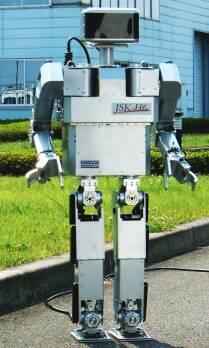
Linux takes over the world, one step at a time—with smaller footprints and larger funding.
Isamu stands 53 inches tall, weighs 121 pounds and walks at over one mile per hour. Not only that, Isamu climbs up and down stairs, carries four-pound objects in its handlike grippers, and even recognizes human faces via its dual-camera stereo vision system. Isamu also has a brain, which consists of a dual-Pentium embedded computer running RTLinux.

Isamu is the product of a joint project of the University of Tokyo's Jouhou System Kougaku Laboratory (JSK Lab) and the Aircraft and Mechanical Systems Division of Kawada Industries, Inc. (Tokyo, Japan). The goal of the project is to develop testbeds for research on “human interactive motion control technology”. For example, Kawada Industries plans to explore possible commercial applications in markets such as construction systems, disaster relief, aids for the disabled, rehabilitation and training devices, and amusement.
In order to mimic humanlike movement, Isamu has thirty-five degrees of freedom: six for each leg, one for each foot (a toe joint), seven for each arm, one for each gripper, two for the neck and three for the eyes. The on-board computer, equipped with dual 750MHz Pentium III processors running RTLinux, provides real-time servo and balance compensation, and coordinates the robot's 3-D vision and motion-planning software modules.
Thanks to an ample battery pack, a wireless Ethernet interface and the powerful on-board computer, Isamu can operate without the need for external cables or constant human intervention. A joystick can be used to direct the robot's movements when human control is desired.
Isamu's bipedal walk, control-system software was developed by the JSK Lab, while the hardware and robotics structures, including the servo-based, level control system, were developed by Kawada Industries. Kawada applied aircraft technologies to the body frame, resulting in a strong and light structure. Visit the JSK Lab's web site (jsk.t.u-tokyo.ac.jp), where you can view some amazing videos showing some of the things Isamu can do.
Empower Technologies has announced what it calls “the world's first major operating system upgrade for Palm IIIx and IIIxe handhelds”. A preliminary demo version of Linux DA is available for free download from the company's web site. Although the demo version is limited to only the most basic PDA functions (address, schedule, calculator, notepad and a few games), the commercial version will add functions such as web browsing, e-mail, multimedia and a lot more. The company says its Linux DA was derived from the standard Linux kernel, with the addition of homegrown software for a GUI, database, power management, boot loader, Flash loader, data sync, IrDA and PIM functions. See empower-technologies.com for details.
XOE Device Platform
Transvirtual Technologies, Inc. has closed a four-million-dollar funding round and is using much of the new capital to launch a new Java/XML-based information appliance platform, called eXtensible Operating Environment (XOE). XOE (pronounced “zo' ee”) evolved Transvirtual's PocketLinux Linux/Java environment for handheld computers, along with a number of XML-based client and server functions. The result, according to Transvirtual, is “a faster, cheaper and more flexible solution specifically engineered for small, resource-constrained information appliances such as PDAs, web-enabled mobile phones, automotive telematics and TV settop boxes”. Although initially targeted to embedded Linux-based devices, XOE will eventually support other embedded OSes as well. See transvirtual.com for details.
Axis Communications, maker of the ETRAX system-on-chip, has integrated over 50 components into a multichip module (MCM) in a standard 27 × 27mm PBGA IC package. Axis says just two external components are needed to end up with a fully functional Linux system: a 20MHz crystal and a source of 3.3 V power. The new MCM contains Axis' ETRAX 100LX RISC-based system-on-chip processor, plus all the most common components normally put in designs based on the device, such as DRAM, Flash, an Ethernet transceiver and “glue” components. Axis says it has run Linux and a small application program successfully, entirely within the MCM's built-in 2MB Flash and 8MB SDRAM. A development board and sample schematics of typical applications for the device are available. Samples are expected in this month. Pricing has yet to be finalized but is expected to be in the range of $50 US (10K units) to $75 (single units). See developer.axis.com for details.